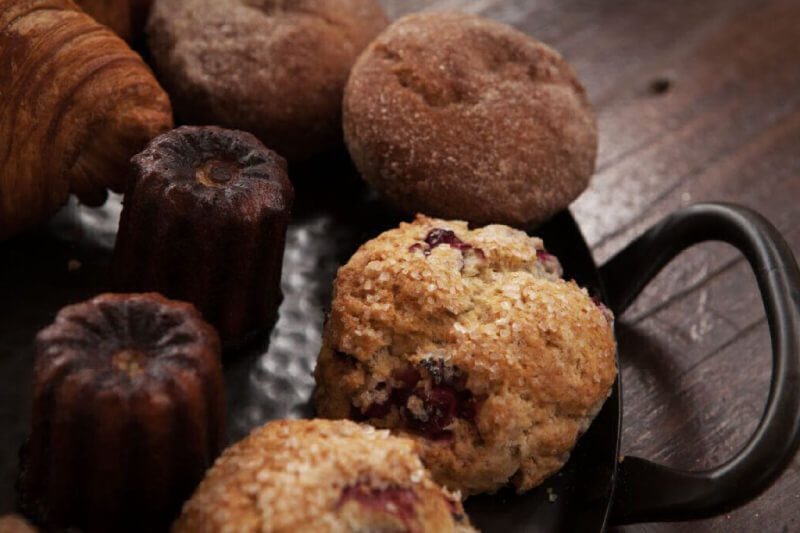Baked Goods

Key Points
- Stevia’s stability throughout the baking process makes it a great choice for reducing sugar in baked goods
- Bulking agents, such as inulin, work well in stevia based, reduced-sugar formulations to replace the bulk sugar contributes in full-sugar, full-calorie products
- Partial-sugar replacements of up to 50% yield consumer acceptable baked goods without significant reformulation
Introduction
Over the past 50 years, consumption of sugar has increased in many parts of the world, and has been implicated as a contributor to obesity, diabetes and other related diseases. In many parts of the world, including Europe, sweet products such as cakes, cookies, muffins and biscuits are the highest contributors to total sugar intake.1 Stevia is a great choice for reducing the sugar found in many of these products since it remains stable throughout the baking process. This section will discuss the taste benefits, as well as the functional challenges of incorporating stevia into bakery applications.
Using Stevia to Bake With Less Sugar
Sugar is one of the most important ingredients in many bakery products. Not only does it provide a sweet taste, it also contributes to crispness, cell structure, browning, tenderization and shelf stability. In addition, sugar provides considerable bulk to baked goods such as cakes and pastries. This is one of the major challenges when replacing sugar with stevia. Other considerations for baking applications include mouthfeel, sweetness, flavor perception and water activity control.
When working with stevia, a wide variety of bulking agents can be incorporated such as maltodextrins, sugar alcohols or fibers. In addition, tools such as hydrocolloids and protein can assist with the loss in structure due to sugar removal. Each ingredient comes with its own set of considerations depending on the level of sugar reduction, application and processing parameters.
Research confirms the benefits of incorporating bulking agents such as fiber into stevia sweetened bakery products. In a recent study of 20% reduced-sugar chocolate muffins formulated with stevia, a 6% addition of cocoa dietary fiber was considered the optimal level for texture, sweet taste and cocoa flavor.2 Another study found that the addition of coffee silver-skin (fibrous husks) improved moisture and color in reduced-sugar biscuits made with stevia.3 In addition to bulking agents, additional moisture can help create a texture closer to full-sugar versions.
Research focusing on the texture of reduced-sugar baked goods made with stevia indicates that a partial-sugar replacement is more acceptable than a 100% replacement. In a study of muffins made with stevia extract and inulin, a replacement of 50% sugar resulted in muffins similar to the full-sugar control for texture, firmness and springiness.4 Additional research on muffins suggests that a 25% sugar replacement using a stevia sweetener yielded a texture, color, cooking yield, browning index and sensory profile similar to the control.5
There are several benefits to note when incorporating stevia-based sweeteners into bakery applications. Stevia is generally heat stable so no sweetening power is lost when baking. The sweetness of stevia is also stable throughout the shelf life of bakery products. In addition, stevia can enhance certain flavors in baked goods such as salt, spice and brown aromatics.
Stevia is a valuable tool for reducing sugars in bakery applications. The functional nature of sugar in many of these products necessitates the addition of bulking agents and other ingredients to better mimic full-sugar versions. With proper development, reduced-sugar products made with stevia can be acceptable substitutes to full-sugar versions from both a sensory and functional standpoint.
REFERENCES
- Azaïs-Braesco V, et al. A review of total & added sugar intakes and dietary sources in Europe. Nutr J 2017;16:6. https://doi.org/10.1186/s12937-016-0225-2
- Karp S, et al. Combined use of cocoa dietary fibre and steviol glycosides in low-calorie muffins production. Int J Food Sci Technol 2017;52:944–53. https://doi.org/10.1111/ijfs.13358
- Garcia-Serna E, et al. Use of coffee silverskin and stevia to improve the formulation of biscuits. Pol J Food 2014;64:243-51. https://doi.org/10.2478/pjfns-2013-0024
- Gao J, et al. Effect of sugar replacement with stevianna and inulin on the texture and predictive glycaemic response of muffins. Int J Food Sci Technol 2016;51:1979–87. https://doi.org/10.1111/ijfs.13143
- Karp S, et al. A. Physical properties of muffins sweetened with steviol glycosides as the sucrose replacement. Food Sci Biotechnol 2016;25:1591–96. https://doi.org/10.1007/s10068-016-0245-x

